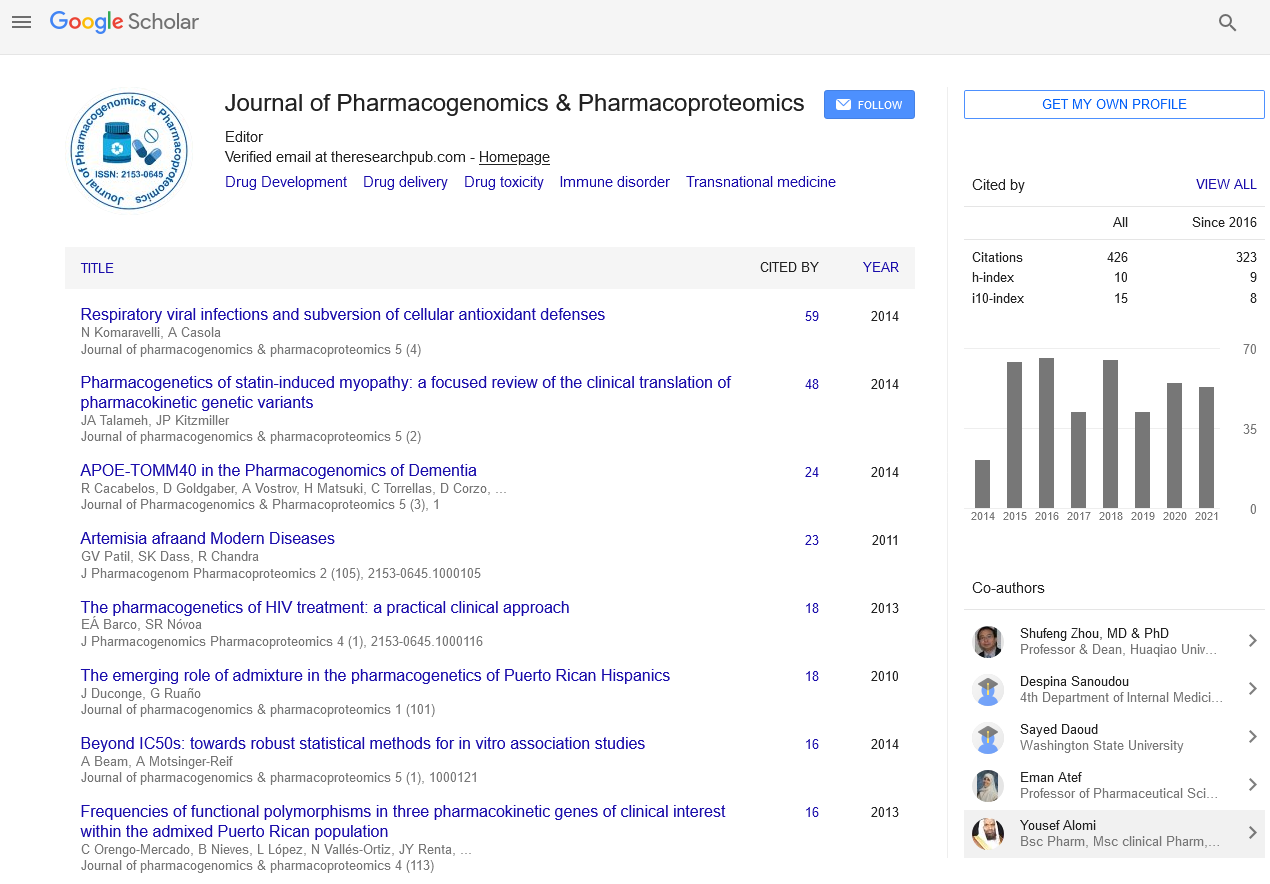Indexed In
- Open J Gate
- Genamics JournalSeek
- Academic Keys
- JournalTOCs
- ResearchBible
- Electronic Journals Library
- RefSeek
- Hamdard University
- EBSCO A-Z
- OCLC- WorldCat
- Proquest Summons
- SWB online catalog
- Virtual Library of Biology (vifabio)
- Publons
- MIAR
- Euro Pub
- Google Scholar
Useful Links
Share This Page
Journal Flyer

Open Access Journals
- Agri and Aquaculture
- Biochemistry
- Bioinformatics & Systems Biology
- Business & Management
- Chemistry
- Clinical Sciences
- Engineering
- Food & Nutrition
- General Science
- Genetics & Molecular Biology
- Immunology & Microbiology
- Medical Sciences
- Neuroscience & Psychology
- Nursing & Health Care
- Pharmaceutical Sciences
Graphene-based biosensors for nano-and pico-applications: A bright future for personalized medicine
2nd International Conference on Predictive, Preventive and Personalized Medicine & Molecular Diagnostics
November 03-05, 2014 Embassy Suites Las Vegas, USA
Farid Menaa
Accepted Abstracts: J Pharmacogenomics Pharmacoproteomics
Abstract:
Nanotechnology and smaller scale technologies represent golden eggs for medicine and sciences. In the recent years, graphene (G)-based biosensors, including functional graphene oxide (GO), G hybrid nanocomposites, are increasingly explored for real-time imaging and quantification of biomolecules or cells. The remarkable intrinsic and tunable properties of G and derivatives (e.g. planar structure, high surface-volume ratio, high electrical conductivity, good chemical stability and strong mechanical strength) are quite attracting to manufacture reliable, highly sensitive and ultra-fast biosensing platforms (e.g. label-free or fluorochrome-based nano-optical/biophotonic detection systems such as FRET or CRET). A number of emerging studies have reported a combination of functional, green, cost-effective and scalable approaches to constantly improve the overall properties (e.g. sensitivity, specificity/selectivity, stability, rapidity, reproducibility) of the G component for real-time and multiplexed imaging of biomolecules (e.g. biomarkers of disease, nucleic acid alterations) or cells (e.g. cancer cells, stem cells, bacteria or viruses). G and derivatives-based biosensors, which besides can be used as nano-vehicles for drug delivery, are revolutionizing the disease prognosis, diagnosis and therapy. The possibility to detect and characterize a single cell or very lowly expressed biomolecules makes G-derived biosensors among the most promising tools for efficient translational, integrative, regenerative and personalized medicine. However, although the cell viability in vitro is not affected, the potential nanocytoxicity (i.e., nanocompatibility and consequences of uncontrolled nanobiogradability) in a clinical setting using humans remains unknown. Eventually, the establishment and compliance of international regulatory industrial and healthcare guidelines before commercialization and translational medicine are still requested. Owing to the possible synergic or additive effects of fluorine and graphene-based materials for efficient personalized medicine, some of our ongoing projects consist to: (i) fully characterize fluorinated-G by our pioneered tool and associated state-of-the-art methods called carbonfluorine spectroscopy (aka SpectroFluorTM) platform; (ii) deeply assess fluorinated-G nanosystems for controlled tumor-site targeted drug delivery. My keynote speech will particularly focus on recent advances of G-based biosensors and highlight their interest for personalized medicine, which in fact aims to improve not only the diagnosis and prognosis of patients but also the current therapeutic strategies.
Biography :
Farid Menaa has completed his PhD with Summa Cum Laude in 2003 from French Energy Atomic Authority (CEA/CEN-Paris), French Ministry of Defense, and postdoctoral studies from Sidney Kimmel Cancer Center/Sanford-Burnham Medical Research Institute-USA (2004-2007, Oncology), University of Wuerzburg- Germany (2007-2009, Dermatology and Stem Cells), Unicamp-Brazil (2010-2012). He is international consultant in cancer nanomedicine, gerontology, cosmetology, food nanotechnology and regenerative medicine. He is also the executive Director of Fluorotronics, Inc., a chemical and nanotech company, and co-pioneered the Carbone-Fluorine related analytical methods for biomedical and pharmaceutical (nano-) applications. He has published numerous papers, serves as an editorial board member in reputed journals, and co-organized several international events on nanomedicine and nanobiotechnology.


